



The Business of Ballooning
Whether
for fun or money,
this sport has its rewards
Area
hot air balloon pilots find solace
aboard gentle giants
By
Don Ward
Editor
|
How
do hot air Courtesy
of www.hotairballooning.com |
|
Hot
air ballooning •
How do you steer a balloon? Balloons simply float with the
wind. The pilot can control the balloon’s altitude to find
a wind going in the desired direction, but he cannot fly upwind
or crosswind. Preflight planning insures the pilot knows which
way the balloon will be traveling, and the pilot makes sure there
are plenty of suitable landing sites downwind. |
(October 2005) – A loud hum broke the silence of
the foggy, mid-August morning in Madison, Ind., when Tom Steinbock turned
on the large fan that he had strategically aimed into the opening of
his deflated hot air balloon. The air rushed into the balloon, slowly
giving it shape.
Little by little, the balloon lifted off the dew-covered grass in the
back yard of the North Madison United Methodist Church. Even though
it was 7 a.m. on a Saturday, surprisingly the loud hum did not cause
anyone to emerge from the rows of houses on either side of Taylor Street.
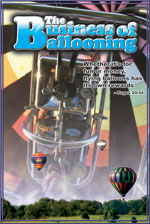 |
|
2005
October
Edition Cover |
As his team of helpers stretched out the colorful envelope,
Steinbock began lighting small bursts of propane into the balloon. The
team sat the wicker basket upright. Steinbock, a construction worker
from Crestwood, Ky., gave the propane one more blast, then said, “Time
to get in.”
I lifted one leg, then another into the basket and slid into place.
Steinbock crawled in, keeping one hand near the propane controls above
his head. His team held on until Steinbock gave them the final command
to let go.
We began to ascend slowly into the air, rising above the trees and houses
and the church. The propane blasts lifted us higher into the skies above
Madison and the wind carried us northeast toward Clifty Drive. Not one
person witnessed our departure. Even the chase team in the van down
below made a clean getaway on that quiet, sleepy morning.
Other than the occasional propane blast and our own voices, the ride
aboard the wicker basket was silent. We glided effortlessly parallel
to Clifty Drive, over Anderson Elementary School, Miles Ridge subdivision,
Staples and Wal-Mart, then out toward our first designated target drop
at the North Madison Christian Church on Hwy. 62. Our balloon drifted
too far right of the target area to make a good throw of the bean bag,
so on we sailed eastward over Cozy Acres Golf Course and eventually
above a foggy ravine that led south down toward the Ohio River. We spotted
several deer in some of the fields below.
Behind us on the horizon were dozens of colorful balloons in hot pursuit
as part of the Madison Ribberfest Hare and Hound Competition. Each one
had taken off at a different location on the Madison hilltop in an attempt
to fly their balloon over the predetermined target areas.
As we drifted over one farm, the cattle below us ran frantically around
in circles, obviously startled. Not one person was outside of their
homes that early in the morning as we passed overhead.
About 20 minutes into the flight, we approached our second target area,
but again we sailed too far to make a good throw – then more
woods and farmland until finally we saw some open fields on the ridge
up ahead near the Canaan water tower. Steinbock decided one field would
make a good landing area. He stayed in constant communication by radio
with his chase team below, who trailed in a van. During the flight,
he also made sure to stay clear of any powerlines – a balloonist’s
worst enemy.
Steinbock gave his team final instructions on where he was about to
land. Once the team had us in their sights, he slowly began our descent.
“Hang on tight,” Steinbock warned in the final minutes before
touchdown.
Our basket bounced a few times along the grassy field before coming
to a stop and gently tipping over. I hopped out.
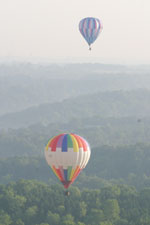 |
|
Photo by Don Ward Gentle Giants in flight. |
Steinbock also exited the basket and began deflating the
envelope. Within minutes, the chase team arrived, and soon we were all
working to mash the air out of the balloon, roll it up and stash it
back into the van.
As we packed up, about a dozen other hot air balloons started landing
in the fields all around us. The landowners and their neighbors came
out to watch in amazement as these colorful balloons sat down. Some
of their neighbors soon joined them.
The entire adventure, from the initial pilots’ meeting at 6:30
a.m. along the riverbank in Milton, Ky., until our arrival back at the
riverfront at 8:30 a.m. took only two hours.
•••
Hot air ballooning has become a growing pastime for private
and commercial pilots alike. And you don’t have to own a balloon
to be a pilot. Many commercial pilots own several balloons and need
help to fly them at multiple events during the same weekend.
“It’s definitely an addictive hobby,” said Travis Vencel,
39, of Bloomington, Ind.
He had his first hot air balloon ride at age 16. Today, he owns three
balloons but has owned as many as five at one time. “As a kid growing
up, for me it was balloons, not fire trucks,” he said.
Vencel has a commercial pilot’s license, which means he can charge
customers for rides, and he can charge companies to put their name on
his balloons. He’s flown for such companies as People’s State
Bank, Damon’s restaurants and Jasper Engine & Transmission.
His main balloon today sports the name of the Bloomington Convention
and Visitors Bureau. That is the balloon he brought to Madison for the
Ribberfest competition.
“I got hooked when Malcolm Forbes brought his hot air balloon to
Bloomington. That was in 1972,” said Vencel, a 1989 Hanover College
graduate. Twenty-two years after his first ride in a balloon, Vencel
figures he’s flown about 1,400 times. He gives rides to about 150
passengers a year during his 75 or so flights. He charges $195 for one
person and $375 for two. Although he works in real estate for his real
job, he says ballooning is a close second. “It’s not a full-time
job, but it’s a full-time hobby.”
Vencel also is vice president of the Montgolfier Society of Indiana,
the state’s hot air ballooning club.
Like many other balloonists in Indiana and Kentucky, in early October
Vencel is heading to the world’s largest balloon event, the Albuquerque
International Balloon Fiesta in New Mexico. The annual 10-day festival
attracts more than 800 balloons each year.
Regionally, the largest balloon event is the Adams Matthews Foundation
Balloon Festival, which took place Sept. 23-25 in Louisville. But dozens
of festivals across Indiana and Kentucky have found that a balloon event
adds color and excitement to the weekend’s activities. And balloonists
are more than happy to oblige them.
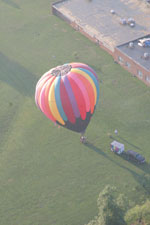 |
|
Photo by Don Ward A
balloon prepares |
“It’s like one big happy family when you consider
all the people you meet in the sport,” said Kevin Toby, 31, of
Henryville, Ind., near Scottsburg. The landscaper has only had his private
pilot’s license for two years, but he already owns two balloons.
“My first one was getting a little worn, so I decided it was time
to upgrade.”
He bought a second used balloon but says with proper care, they can
last for many years.
“My uncle flew balloons 20 years ago, and I had always been fascinated
by them. So when I finally got old enough and could afford it, I got
my license.”
That was in 2003. Today, Toby finds himself wanting to fly more and
more. In fact, in a few weeks he plans to take his commercial pilot’s
test so he can fly commercially for his friend, Frank McCrory, who owns
several balloons sporting company names in the Scottsburg area.
Toby’s family and friends serve as his chase crew. “That’s
how they earn their rides; the more you work, the more you ride,”
he joked.
Toby noted the family friendly aspect of the sport and said it generates
many friendships.
“You hardly ever just see one balloon in the air; it’s usually
many balloons all flying at once,” he said. “So you get to
know a lot of people with the same interest.”
Vencel teaches prospective pilots how to fly balloons. “I recommend
that they take at least two lessons to see if they like it, then we
go from there,” he said.
He charges $150 per hour if taken in the client’s balloon and $350
per hour if in his balloon.
Granted, it can be expensive. He has trained only about eight people
over 20 years, he said.
A new pilot needs a minimum of 10 flying hours, but Vencel’s students
usually have 15 by the time they are ready to take the written and flight
test. Buying that first balloon, however, can range anywhere from $20,000
up to $100,000, depending on the extra accessories and on how elaborate
the shape of the balloon is, said Tom Steinbock, 44, of Crestwood, Ky.
“You can buy a cadillac or you can buy a volkswagon,” Steinbock
said.
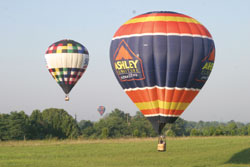 |
|
Photo by Don Ward Two
hot air balloons prepare |
“I relate it to boating – you can spend a lot
of money or buy a used one from a friend down the street,” said
Vencel. Most balloonists carry a $1 million insurance policy as well,
which runs about $800 a year.
Steinbock has flown his own hot air balloon since 1975, but he caught
the flying bug a lot earlier – as a boy growing up next to a neighbor
who flew them. He now flies as a commercial pilot at nearly 20 festivals
a year. Some of his corporate clients include Dairy Queen, Nu Yale Dry
Cleaners, Assumption High School and Bargain Supply. Steinbock belongs
to the Indiana ballooning club but also is a member of the Balloon Society
of Kentucky, which he said is currently undergoing a reorganization.
Steinbock said he enjoys the solitude and freedom that comes with ballooning.
He usually flies low enough to converse with people on the ground. “They
always say ‘hi’ or wave or honk their car horns when they
see us flying over – especially when we go over the interstate.”
Although balloonists use various types of fuel, Steinbock uses regular
propane, which now costs about $1.80 per gallon. He says the sport is
“very safe because we don’t go up if the weather is bad.”
He has never had a close call and, like all pilots, relies on the generosity
of land owners to get back down to earth.
“Generally, people are interested in the balloons and don’t
mind us landing on their property,” he said. “We do everything
we can not to cause any damage to farm crops or property. Usually by
the time we have packed up and are ready to leave, they are our best
friends.”
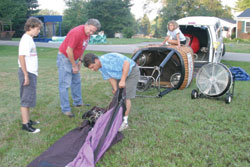 |
|
Photos by Don Ward Tom
Steinbock (center) of Crestwood, Ky., |
Steinbock’s wife, Lisa, has frequently flown with
him or served as his chase person. She says she also enjoys flying but
added, “It’s really Tom’s passion, not mine. I’m
a balloon widow.”
An interior designer, Lisa describes a balloon flight by saying, “It’s
very peaceful; a tranquil experience and very quiet. And the scenery
you see is just beautiful. There’s really no sense of height with
it – just floating when you’re up there.”
She says neither words nor pictures do justice to what it is really
like. “It’s really something you have to experience for yourself.”
If you have ever wanted to learn more about hot air ballooning or have
considered becoming a pilot, Toby recommends getting to know someone
who flies. Many balloon pilots need help setting up for a flight or
chasing the balloons to their landing sights.
“That is a great way to learn about the sport,” he said. “Who
knows, you might even get a few free rides.”
• Learn more about hot air ballooning at these websites: www.hotairballooning.com
or www.balloonindiana.com.